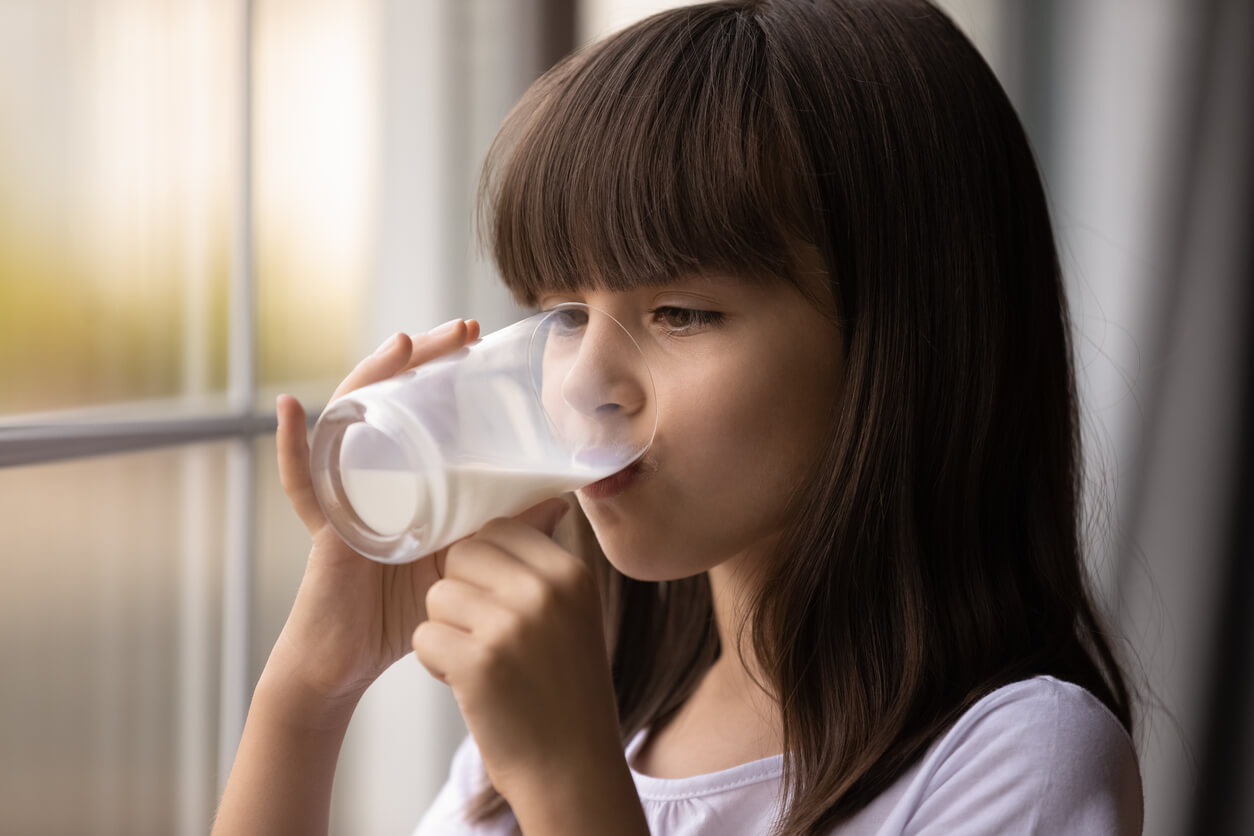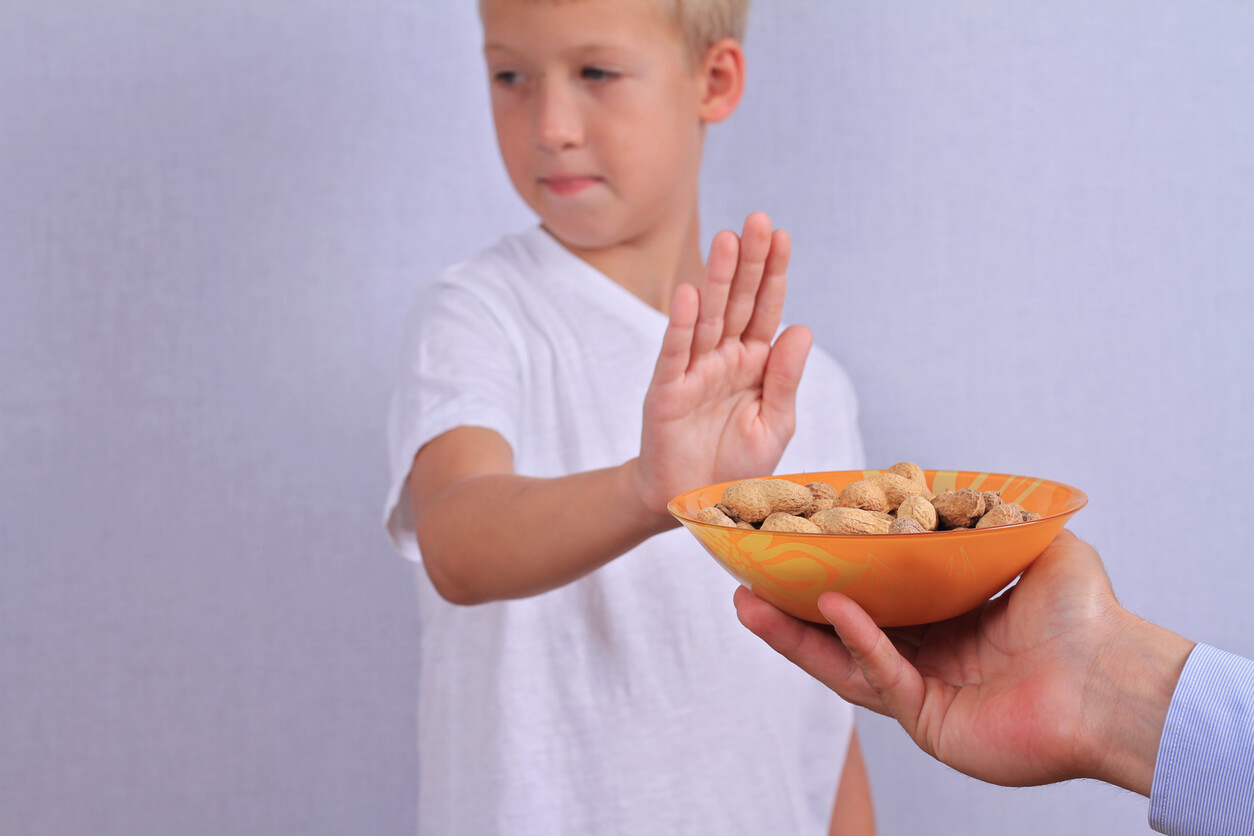7 Most Allergenic Foods for Infants and Children

Food allergies have become a real public health problem. Not only because of the impact they have on the child’s well-being, but also because of the effect on the quality of life of the child and the family. Their prevalence varies between 4 and 8%, with a tendency to increase. In this article, we’ll give you a list of the most allergenic foods for children so that you can make decisions about their consumption.
A severe allergy can trigger anaphylaxis and put the child’s life at risk. So the best action is prevention. Check the most allergenic foods and keep an eye on your little one.
Read also: 10 Questions About Allergies in Children
What is a food allergy?
A food allergy is defined as a defense response of the body to the presence of substances considered invaders by our antibodies. These substances are found in food. The reaction can appear within 30 to 60 minutes after ingesting the food and the mild symptoms are itching, hives on the skin and lips, swollen eyes, and cough, among others. Some allergies also cause vomiting or diarrhea in younger children.
More severe symptoms include low blood pressure, fainting, and difficulty breathing. Anaphylaxis is the most extreme and feared reaction, as it puts the child at vital risk. To avoid it, you should always carry an adrenaline injection prescribed by your pediatrician or allergist.
Discover the most allergenic foods for children
Some foods that seem harmless represent a risk to children’s health. Below, we’ll mention the most allergenic ones. Take them into account when introducing them for the first time in their diet.
1. Cow’s milk
The Spanish Association of Pediatrics states that the most frequent food allergy during the first year of life is to cow’s milk. This generally occurs because the baby’s antibodies, called immunoglobulin E (IgE), react by mistake to the proteins in this food. In addition, it can also occur due to other immune system mechanisms.
The allergy causes reddening of the skin, can spread throughout the body, and may cause swelling of the lips, eyelids, and ears. In some cases, it manifests with vomiting and diarrhea, but anaphylactic shock, which causes severe respiratory distress and other symptoms, is the most dangerous.

2. Hen’s egg
Hen’s egg contains all the essential amino acids, which is why it’s classified as a nutritional gold standard. However, for some children, it may not be as beneficial, as it’s considered by a specialized magazine as the most common cause of food allergy. The egg white is more allergenic than the yolk and its main proteins involved are ovomucoid and ovalbumin.
Symptoms appear immediately or within an hour after consumption. There may be itching in the mouth or throat and red spots. Vomiting, diarrhea, and difficulty breathing appear as the most severe symptoms.
3. Fish
Fish ranks as the third most allergenic food after milk and egg. In this case, it’s frequent during the first or second year of life and can last forever, unlike the foods mentioned above. The trigger may be by ingestion, contact, or even ingestion of its vapors. The protein involved, called parvalbumin, is very stable to heat, so cooking can’t eliminate it.
According to the journal Pediatría Integral, the fish most associated with allergic symptoms are hake, blue whiting, megrim, and, less frequently, bonito, mackerel, and tuna.
The symptoms are similar to those of other animal proteins. Therefore, it presents with itching, redness around the mouth, swelling of the eyes, lips, and ears, sneezing, vomiting, diarrhea, and, less frequently, asthma.
Read also: When Can Children Eat Seafood?
Crustaceans and mollusks
Shellfish allergy is higher in adults than in children. This is the cause of 4 to 6.5% of all allergies in children. However, just because they’re allergic to fish doesn’t mean that they’re also allergic to this group. A protein known as tropomyosin is the cause of the reaction and shrimp is the shellfish most involved in the allergic picture. It is also present in other crustaceans and mollusks.
In general, it’s a persistent allergy and causes anaphylaxis. They may present cough, abdominal pain, diarrhea, vomiting, itching, hives, and difficulty breathing, among others.
5. Nuts
Nuts stand out for their excellent nutritional value and for being a source of proteins, healthy fats, fiber, antioxidants, and minerals. But it’s also important to be careful with older children, as after the age of 3 years, they can cause allergies. In younger children, the reaction occurs to a single nut, so it’s one of the most allergenic foods.
In Anglo-Saxon countries, peanuts cause the most reactions, while in Europe, hazelnuts cause the most reactions. It can also occur with walnuts and almonds. These foods have great potential as allergens, as they’re stable to heat and digestive processes. Therefore, it’s important to check product labels before consumption.
Reactions appear almost immediately and are intense. They’re presented with itching in the body, conjunctivitis, throat and tongue inflammation, as well as respiratory and digestive problems.

6. Legumes
Legumes are the most important source of protein in vegetables. The most implicated in terms of allergies in Anglo-Saxon countries are soybeans and peanuts. But, in Asian countries or in Mediterranean diets, the reaction occurs with lentils, chickpeas, and peas. Reactions occur with itching in different parts of the body, respiratory problems, low blood pressure, and vomiting.
7. Grains
Grains are the main source of energy. However, allergy to these foods is one of the most common causes in the United States. Sensitization to this group usually disappears with age.
Allergic reactions to wheat are sometimes confused with celiac disease. They differ in that allergy is a reaction of the body’s defenses to wheat proteins, whereas in celiac disease, a specific protein, gluten, causes other types of reactions in the immune system.
It’s important to be aware of product labels, as wheat can be present in many foods, such as ice cream, soy sauce, or sausages. As for the symptoms, they’re similar to those of other food allergies: Itching, vomiting, diarrhea, abdominal pain, difficulty breathing, and anaphylaxis.
Final considerations
We must be very careful with the most allergenic foods in our children. When complementary feeding begins, after 6 months of age, the foods on this list should be introduced gradually. In addition, you should always follow the specialist’s instructions. Fortunately, allergies to eggs, milk, wheat, and soy disappear at 5 years of age. On the other hand, those of peanuts, nuts, and shellfish persist over time.
If the child is away from home, the caregivers should be warned about the allergy and which foods to avoid. Also, reading product labels is essential. So, if your child suffers from a food allergy, remember to carry two adrenaline auto-injectors everywhere you go and take care of certain foodstuffs.
Food allergies have become a real public health problem. Not only because of the impact they have on the child’s well-being, but also because of the effect on the quality of life of the child and the family. Their prevalence varies between 4 and 8%, with a tendency to increase. In this article, we’ll give you a list of the most allergenic foods for children so that you can make decisions about their consumption.
A severe allergy can trigger anaphylaxis and put the child’s life at risk. So the best action is prevention. Check the most allergenic foods and keep an eye on your little one.
Read also: 10 Questions About Allergies in Children
What is a food allergy?
A food allergy is defined as a defense response of the body to the presence of substances considered invaders by our antibodies. These substances are found in food. The reaction can appear within 30 to 60 minutes after ingesting the food and the mild symptoms are itching, hives on the skin and lips, swollen eyes, and cough, among others. Some allergies also cause vomiting or diarrhea in younger children.
More severe symptoms include low blood pressure, fainting, and difficulty breathing. Anaphylaxis is the most extreme and feared reaction, as it puts the child at vital risk. To avoid it, you should always carry an adrenaline injection prescribed by your pediatrician or allergist.
Discover the most allergenic foods for children
Some foods that seem harmless represent a risk to children’s health. Below, we’ll mention the most allergenic ones. Take them into account when introducing them for the first time in their diet.
1. Cow’s milk
The Spanish Association of Pediatrics states that the most frequent food allergy during the first year of life is to cow’s milk. This generally occurs because the baby’s antibodies, called immunoglobulin E (IgE), react by mistake to the proteins in this food. In addition, it can also occur due to other immune system mechanisms.
The allergy causes reddening of the skin, can spread throughout the body, and may cause swelling of the lips, eyelids, and ears. In some cases, it manifests with vomiting and diarrhea, but anaphylactic shock, which causes severe respiratory distress and other symptoms, is the most dangerous.

2. Hen’s egg
Hen’s egg contains all the essential amino acids, which is why it’s classified as a nutritional gold standard. However, for some children, it may not be as beneficial, as it’s considered by a specialized magazine as the most common cause of food allergy. The egg white is more allergenic than the yolk and its main proteins involved are ovomucoid and ovalbumin.
Symptoms appear immediately or within an hour after consumption. There may be itching in the mouth or throat and red spots. Vomiting, diarrhea, and difficulty breathing appear as the most severe symptoms.
3. Fish
Fish ranks as the third most allergenic food after milk and egg. In this case, it’s frequent during the first or second year of life and can last forever, unlike the foods mentioned above. The trigger may be by ingestion, contact, or even ingestion of its vapors. The protein involved, called parvalbumin, is very stable to heat, so cooking can’t eliminate it.
According to the journal Pediatría Integral, the fish most associated with allergic symptoms are hake, blue whiting, megrim, and, less frequently, bonito, mackerel, and tuna.
The symptoms are similar to those of other animal proteins. Therefore, it presents with itching, redness around the mouth, swelling of the eyes, lips, and ears, sneezing, vomiting, diarrhea, and, less frequently, asthma.
Read also: When Can Children Eat Seafood?
Crustaceans and mollusks
Shellfish allergy is higher in adults than in children. This is the cause of 4 to 6.5% of all allergies in children. However, just because they’re allergic to fish doesn’t mean that they’re also allergic to this group. A protein known as tropomyosin is the cause of the reaction and shrimp is the shellfish most involved in the allergic picture. It is also present in other crustaceans and mollusks.
In general, it’s a persistent allergy and causes anaphylaxis. They may present cough, abdominal pain, diarrhea, vomiting, itching, hives, and difficulty breathing, among others.
5. Nuts
Nuts stand out for their excellent nutritional value and for being a source of proteins, healthy fats, fiber, antioxidants, and minerals. But it’s also important to be careful with older children, as after the age of 3 years, they can cause allergies. In younger children, the reaction occurs to a single nut, so it’s one of the most allergenic foods.
In Anglo-Saxon countries, peanuts cause the most reactions, while in Europe, hazelnuts cause the most reactions. It can also occur with walnuts and almonds. These foods have great potential as allergens, as they’re stable to heat and digestive processes. Therefore, it’s important to check product labels before consumption.
Reactions appear almost immediately and are intense. They’re presented with itching in the body, conjunctivitis, throat and tongue inflammation, as well as respiratory and digestive problems.

6. Legumes
Legumes are the most important source of protein in vegetables. The most implicated in terms of allergies in Anglo-Saxon countries are soybeans and peanuts. But, in Asian countries or in Mediterranean diets, the reaction occurs with lentils, chickpeas, and peas. Reactions occur with itching in different parts of the body, respiratory problems, low blood pressure, and vomiting.
7. Grains
Grains are the main source of energy. However, allergy to these foods is one of the most common causes in the United States. Sensitization to this group usually disappears with age.
Allergic reactions to wheat are sometimes confused with celiac disease. They differ in that allergy is a reaction of the body’s defenses to wheat proteins, whereas in celiac disease, a specific protein, gluten, causes other types of reactions in the immune system.
It’s important to be aware of product labels, as wheat can be present in many foods, such as ice cream, soy sauce, or sausages. As for the symptoms, they’re similar to those of other food allergies: Itching, vomiting, diarrhea, abdominal pain, difficulty breathing, and anaphylaxis.
Final considerations
We must be very careful with the most allergenic foods in our children. When complementary feeding begins, after 6 months of age, the foods on this list should be introduced gradually. In addition, you should always follow the specialist’s instructions. Fortunately, allergies to eggs, milk, wheat, and soy disappear at 5 years of age. On the other hand, those of peanuts, nuts, and shellfish persist over time.
If the child is away from home, the caregivers should be warned about the allergy and which foods to avoid. Also, reading product labels is essential. So, if your child suffers from a food allergy, remember to carry two adrenaline auto-injectors everywhere you go and take care of certain foodstuffs.
All cited sources were thoroughly reviewed by our team to ensure their quality, reliability, currency, and validity. The bibliography of this article was considered reliable and of academic or scientific accuracy.
- Fernández Rivas M. (2009). Food allergy in Alergológica-2005. Journal of investigational allergology & clinical immunology, 19 Suppl 2, 37–44.
- González Miltos, M , Susana Sánchez Bernal,R. (2021). Alergias alimentarias en pediatría: frecuencia, características clínicas y alergenos más frecuentes en pacientes de un consultorio pediátrico de alergia de referencia. Pediatr. (Asunción); 48(3):187-194 (setiembre – diciembre)
- Iglesias, M. Sepeap. (2018). Alergia a los alimentos. Pediatría Integral, 2, Disponible en: https://www.pediatriaintegral.es/publicacion-2018-03/alergia-a-los-alimentos/
- MayoClinic. Alergia al trigo. Disponible en: https://www.mayoclinic.org/es-es/diseases-conditions/wheat-allergy/symptoms-causes/syc-20378897
- Sampson H. A. (2004). Update on food allergy. The Journal of allergy and clinical immunology, 113(5), 805–820. https://doi.org/10.1016/j.jaci.2004.03.014
This text is provided for informational purposes only and does not replace consultation with a professional. If in doubt, consult your specialist.








